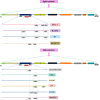Clinical Characteristics, Transmissibility, Pathogenicity, Susceptible Populations, and Re-infectivity of Prominent COVID-19 Variants
- PMID: 35371608
- PMCID: PMC8947836
- DOI: 10.14336/AD.2021.1210
Clinical Characteristics, Transmissibility, Pathogenicity, Susceptible Populations, and Re-infectivity of Prominent COVID-19 Variants
Abstract
In addition to the rapid, global spread of SARS-CoV-2, new and comparatively more contagious variants are of considerable concern. These emerging mutations have become a threat to the global public health, creating COVID-19 surges in different countries. However, information on these emerging variants is limited and scattered. In this review, we discuss new variants that have emerged worldwide and identify several variants of concern, such as B.1.1.7, B.1.351, P.1, B.1.617.2 and B.1.1.529, and their basic characteristics. Other significant variants such as C.37, B.1.621, B.1.525, B.1.526, AZ.5, C.1.2, and B.1.617.1 are also discussed. This review highlights the clinical characteristics of these variants, including transmissibility, pathogenicity, susceptible population, and re-infectivity. It provides the latest information on the recent variants of SARS-CoV-2. The summary of this information will help researchers formulate reasonable strategies to curb the ongoing COVID-19 pandemic.
Keywords: COVID-19; SARS-CoV-2 variants; VOC; VOI; VUM; mutation.
Copyright: © 2022 Yang et al.
Conflict of interest statement
Conflicts of Interest No potential conflict of interest was reported by the authors.
Figures





Similar articles
-
SARS-CoV-2 variants and COVID-19 vaccines: Current challenges and future strategies.Int Rev Immunol. 2023;42(6):393-414. doi: 10.1080/08830185.2022.2079642. Epub 2022 May 28. Int Rev Immunol. 2023. PMID: 35635216 Review.
-
Modeling SARS-CoV-2 spike/ACE2 protein-protein interactions for predicting the binding affinity of new spike variants for ACE2, and novel ACE2 structurally related human protein targets, for COVID-19 handling in the 3PM context.EPMA J. 2022 Jan 6;13(1):149-175. doi: 10.1007/s13167-021-00267-w. eCollection 2022 Mar. EPMA J. 2022. PMID: 35013687 Free PMC article.
-
Emergency SARS-CoV-2 Variants of Concern: Novel Multiplex Real-Time RT-PCR Assay for Rapid Detection and Surveillance.Microbiol Spectr. 2022 Feb 23;10(1):e0251321. doi: 10.1128/spectrum.02513-21. Epub 2022 Feb 23. Microbiol Spectr. 2022. PMID: 35196812 Free PMC article.
-
Most frequently harboured missense variants of hACE2 across different populations exhibit varying patterns of binding interaction with spike glycoproteins of emerging SARS-CoV-2 of different lineages.Comput Biol Med. 2022 Sep;148:105903. doi: 10.1016/j.compbiomed.2022.105903. Epub 2022 Jul 20. Comput Biol Med. 2022. PMID: 35932731 Free PMC article.
-
SARS-CoV-2 Mutations and Their Impact on Diagnostics, Therapeutics and Vaccines.Front Med (Lausanne). 2022 Feb 22;9:815389. doi: 10.3389/fmed.2022.815389. eCollection 2022. Front Med (Lausanne). 2022. PMID: 35273977 Free PMC article. Review.
Cited by
-
CD147 mediates S protein pseudovirus of SARS-CoV-2 infection and its induction of spermatogonia apoptosis.Endocrine. 2024 Sep;85(3):1435-1445. doi: 10.1007/s12020-024-03891-4. Epub 2024 Jun 1. Endocrine. 2024. PMID: 38824220
-
Sequential viral introductions and spread of BA.1 across Pakistan provinces during the Omicron wave.BMC Genomics. 2023 Aug 3;24(1):432. doi: 10.1186/s12864-023-09539-3. BMC Genomics. 2023. PMID: 37532989 Free PMC article.
-
Developing a COVID-19 Mortality Prediction (CoMPred) Indicator for ICU Diabetic Patients Treated with Tocilizumab in Saudi Arabia: A Proof-of-Concept Study.Biomedicines. 2023 Sep 27;11(10):2649. doi: 10.3390/biomedicines11102649. Biomedicines. 2023. PMID: 37893025 Free PMC article.
-
Spike substitutions E484D, P812R and Q954H mediate ACE2-independent entry of SARS-CoV-2 across different cell lines.PLoS One. 2025 Aug 1;20(8):e0326419. doi: 10.1371/journal.pone.0326419. eCollection 2025. PLoS One. 2025. PMID: 40749010 Free PMC article.
-
SARS-CoV-2 and male infertility: from short- to long-term impacts.J Endocrinol Invest. 2023 Aug;46(8):1491-1507. doi: 10.1007/s40618-023-02055-x. Epub 2023 Mar 14. J Endocrinol Invest. 2023. PMID: 36917421 Free PMC article. Review.
References
Publication types
LinkOut - more resources
Full Text Sources
Miscellaneous
